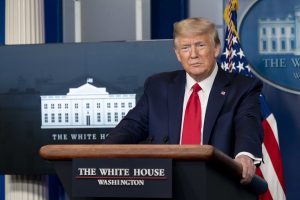For months now, the Trump administration has increasingly been addressing issues that have festered within the framework of the U.S.-China relationship for more than three decades. None of the outcomes have been in China’s favor.
Back on January 15 of this year, things looked rosier between the United States and China. On that day in the golden-toned East Room of the White House, the president celebrated the signing of the first phase of the long-negotiated U.S.-China Phase One trade deal. The room was packed with officials and supporters of the president. Only the Chinese delegation looked less than enthusiastic about its role in the proceedings.
No one in that room could have imagined that 16 days later Trump would ban flights from China as a first attempt to stop the spread of the novel coronavirus from mainland China to the United States.
And few, if any, would have believed that nearly nine months later, the president of the United States would tell another audience gathered at the White House, this time for a celebration of Labor Day, that “decouple” is an “interesting word.”
“China is spending the money we give them to build up their military,” Trump told assembled guests.
“So when you mention the word ‘decouple,’ it’s an interesting word. So we lose billions of dollars, and if we didn’t do business with them, we wouldn’t lose billions of dollars. It’s called ‘decoupling.’ So you’ll start thinking about it. You’ll start thinking.”
There is no question but that the pivot from deal to decoupling in Trump’s mind came with the realization that in January, as COVID-19 began to move quickly throughout China, the Chinese government deliberately closed down the movement of people within China, but not the movement of people from China to the rest of the world. The profound implications of that decision are seen daily in the statistics of the sickness and death that the whole world has experienced since.
The list of trade and security-related actions that Trump has taken to curtail economic and security-related threats from China is a comprehensive one. They include stiff tariffs on a wide range of Chinese imports, and sanctions on China over the Hong Kong national security law. Trump has designated not only Chinese state-run media outlets in the United States, but also the Confucius Institute U.S. Center as foreign missions, requiring detailed disclosures of personnel and property to the U.S. State Department. He has forced the sale of TikTok’s U.S. operations to a U.S company as a condition of continuing to operate in the United States.
These and many other steps have been taken by the Trump administration to shut down perceived Chinese espionage and influence activities in the United States that accompany the trade imbalances Trump promised to correct.
Now, however, the Trump administration’s actions, most of them made since January of this year, enticingly raise the question of how much further U.S. actions can go before actually changing the fundamentals of U.S. policy toward China.
Consideration of that idea is all the more important in the context of the recent U.S. State Department announcement of closer ties and renewed initiatives with Taiwan.
In early August, Health and Human Services Secretary Alex Azar visited Taiwan, the highest-ranking U.S. official to do so in the 41 years since the United States switched its diplomatic recognition of China from Taipei to Beijing.
And on August 31, David Stilwell, U.S. assistant secretary of state, announced that “the U.S. and Taiwan are establishing a new bilateral economic dialogue. These talks will explore the full spectrum of our economic relationship – semiconductors, healthcare, energy, and beyond – with technology at the core.”
Is there a possibility that the bedrock foundation of U.S. policy toward China could face a previously unthinkable readjustment? Could the heretofore unassailable One China policy actually come under threat?
Stilwell, speaking at a virtual Heritage Foundation event, took the opportunity to deny that possibility.
He made a point of saying that “we have changed nothing about… longstanding policies. What we are doing, though, is making some important updates to our engagement with Taiwan to better reflect these policies and respond to changing circumstances. The adjustments are significant, but still well within the boundaries of our one-China policy.”
“The truth is, what I have just outlined is entirely consistent with our longstanding policy,” Stilwell said.
Formal U.S. policy toward China is couched within several agreements. Those are the three joint communiques between the United States and China, and the Taiwan Relations Act of 1979.
And then there are the lesser known Six Assurances, a set of commitments made by Ronald Reagan to Taiwan during his first term as president. Stilwell said those “endure today.” Two of those assure Taiwan that “the United States has set no date for ending arms sales to Taiwan,” and that “the United States has not agreed to prior consultation with Beijing on arms sales to Taiwan.”
“It is important to review history like this because Beijing has a habit of distorting it,” Stilwell said. On a possibly related note, the actual documents containing those assurances were recently declassified and released to the public.
As open to interpretation as Stilwell’s comments may be, however, there is no mistaking the message that the president himself sent at the Labor Day event.
China is “talking to us much differently than they used to, because if they don’t shape up, we’re going to ship out. That’s all,” Trump said.
Trump took it a step further and stated in the turn of one sentence his intention to change the course of U.S.-China relationship. “We’re going to end our reliance on China because we can’t rely on China,” the president said.

































